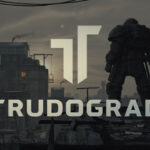Warning: Liyla and the Shadows of War, and this review, contain content and themes that may be distressing to certain audiences. Discretion is advised.
Liyla and the Shadows of War is a game about war.
Specifically, it is about the 2014 Gaza war, as told from the perspective of a civilian desperately trying to get his wife and daughter to safety.
Liyla and the Shadows of War is not a happy game.
It’s also by far the shortest game I’ve reviewed, and I’m including Dr. Lengeskov, The Tiger, and Etcetera from my list of Top 10 Free to Play Indie Games from the end of last year.
It won several awards and was nominated for something like a dozen more when it was released, and I can see why.

Gameplay
I know that I usually put a joke or something in these headers, but for Liyla, I’m just not feeling up to it. This fifteen-minute game made me cry, okay?
Liyla and the Shadows of War has some incredibly simplistic gameplay. It’s a puzzle platformer. You move around, you jump, and at certain points you can interact with object in order to affect the environment in a safe way. I’m reminded somewhat of Limbo or Inside, and not just because of the aesthetic.
Puzzles are short and simple and very straightforward. The first puzzle is actually the hardest, where you have to navigate around a ruined building so you can reach a dumpster for cover. Part of the simplicity of the puzzles comes from how incredibly forgiving the game is for failure. Dying causes you to restart the current screen with all your progress intact.
On one hand, this makes most of the puzzles insultingly easy. On the other hand, the game does not pull its punches with character death.
Liyla was released for phones as well as PC, and it shows that it was designed with mobile in mind.
The platforming is a bit odd. This is a weirdly specific comparison, but it feels like an old online flash game I played as kid on the Scholastic Books website. Jumps are very floaty, and your falling speed is noticeably slow. It’s not enough to actually interfere with gameplay, as the jumps were all designed with the game’s controls in mind, but it does still feel very weird to control.
Later in the game, the puzzles are replaced with sections of visual-novel style choices, where the wrong choice results in the death of you and/or your family, and then you try again, choosing the correct option. This is, strictly speaking, gameplay at its absolutely most basic. I’d be more annoyed at these sections, but again, this game is like fifteen minutes long and these sections are based on real events. The quick restarts don’t hurt either.

Art
Lilya and the Shadows of War has a very strong monochromatic aesthetic. Everything in the foreground is either a stark black or white, with lighter grays in the background. This not only makes it easy to see what you can and cannot interact with, but makes the small uses of color stand out all the more.
And it makes a very consistent choice to only use color for fire and bullets. In other words, if you see color, it is always a very bad thing.
Also Read
Transmogrify PC Review: The Best Way To Defeat An Enemy
A video game protagonist wakes up in an on-fire science lab with nothing but an AI and a high-tech gun to…
Defy the Gods as a Witchy Moon Goddess in Hades 2
Greek-mythology-themed roguelike Hades is getting a sequel, but developer Supergiant has kept the details scant beyond a Hades 2 reveal trailer…
From gunfire to rocket trails to burning buildings to white phosphorus, if you see color, you run.
Soundwise, Liyla and the Shadows of War uses mostly stock sound effects from an online library, according to the credits. Sound in Liyla is used sparingly, and had they not credited the site, I wouldn’t have recognized any of them. There is also a single piece of music in the game, used at the very end. The audio quality was unfortunately not as good as it could have been, but the song itself was good.
This all being said, I experienced a rather frustrating audio glitch, though if I am correct about what caused it, the odds of anyone ese experiencing the issue is rather low. Due to a mistimed movement, I was killed at the exact moment I reached the end of a screen to transition to the next screen. The result was that the footsteps sound effect never stopped playing. I consider it a testament to how powerful the game’s ending is that I was still so affected by it even as the sound effect continued undermining the scene.
The game’s story is, well, it’s a war story about civilians. I figured out how it was going to end pretty quick, and I’m sure you have some idea already. But it’s also really well done. There’s also the fact that the game shows the statistics from the actual Gaza War at the end of the game, reframing some of the things you saw and experienced as the very real tragedies they were that affected—and killed—real people.

Conclusion
Liyla and the Shadows of War compensates for simplistic gameplay with a strong presentation and a powerful message it wants to share. The developer describes the game as a call for help. I completely understand. And unfortunately, the central themes this game touches on are still relevant today. Perhaps even more so, given recent events.
Our Rating
Story
Graphics
Controls










